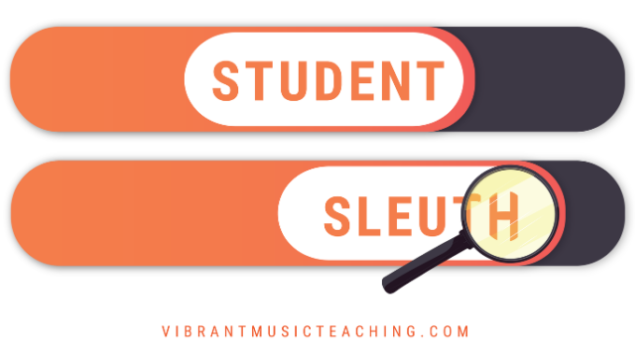
This blog post about piano students using memorisation as a crutch was written by Joanna Shiel. Joanna works on the editorial team at Colourful Keys and Vibrant Music Teaching. She’s been teaching piano for 14 years, and now runs her own online piano school. Her dessert of the month is pistachio-flavoured ice cream.
Ever had your socks blown off by a transfer student who can play Beethoven’s ‘Moonlight Sonata’ flawlessly, yet struggles to work their way through a new level 1 piece without assistance?
It’s probably safe to assume they’ve learnt the sonata largely by rote and ear without truly understanding the piece, memorising mechanically as they went along.
How can we help this type of student match their playing and performance ability to their theoretical understanding?

Every once in a while, I’ll have a transfer student come through my door who’s gotten by with simply memorising a piece rather than truly having a deep comprehension of the music they’re playing.
It’s almost like a parrot who mimics human words but can’t really carry on an actual conversation. 🦜
More often than not, these students have poor sight reading skills, rely too heavily on muscle memory and lack music theory knowledge.
If I was to ask these students to start from bar 20 of the aforementioned ‘Moonlight Sonata’, a piece they could play flawlessly from memory, they’d probably be completely stuck.
For these piano students, memorisation has become a crutch rather than a natural result of mining the depths of musical elements like form, harmonic structure and articulation.
Root Causes of “Crutch” Memorisation
Memorisation becomes a crutch when piano students aren’t given diverse opportunities, time and space to learn music through a variety of means.
I find this most often happens when piano students are:
- Mired in learning a limited repertoire over a long period of time, perhaps polishing pieces up for a performance, festival or exam
- Exposed only minimally to music outside of their weekly piano lesson
- Pushed to learn – or insist on playing – overly ambitious pieces which are well beyond their current level of understanding
- Stuck learning solely from music notation rather than experiencing music through a variety of means such as composition, improvisation, rote pieces and aural activities
4 Qualities of a Healthy Memoriser
A student who has memorised in a healthy way knows the puzzle pieces of the music they’re playing and has a solid understanding of where, how and why those pieces fit together.

As the student is putting this “musical puzzle” together, memorisation becomes a natural part of the learning process.
This isn’t to say that piano students will magically remember the piece after only a few playings. But with good, intentional practice tools and habits, committing the music to memory will feel far easier.
A transfer student who is a healthy and fit memoriser will have these 4 indicators:
1. Pattern & Shape Recognition
Students who see the piano keyboard in collective shapes rather than individual, unconnected notes and keys tend to make excellent sight readers.
Not only do they sight read well, these players use their understanding of patterns to enhance the memorisation process.
2. Composer & Genre Connections
The healthy memoriser is able to interlink repertoire more broadly from the same composer, and recognise composers from the same musical period or genre.
Along with noticing similarities, these students are likely to spot the differences between composers, eras and styles.
3. Expressive Playing
Players with fantastic sound are great at focussing on the expression and character of a piece.
This only happens when students truly have a deep, comfortable and broad knowledge of the music they’re playing.
4. Composition-Driven Knowledge
Students who are comfortable with improvisation, arranging and composing will have a solid understanding of harmony, scale work and rhythm – important keys to memorisation.
Breaking the Memorisation “Crutch”
To make sure that transfer students start to develop the habits of “good” memorisation instead of relying on “bad” memorisation, try these 3 steps.
Step 1: Discover Knowledge Gaps
Your first point of call is going to be working out what your transfer student knows and doesn’t know.
Use Games & Improvisation
I love to use the first interview or trial lesson as an opportunity to play a few games and activities that test different elements of piano playing while keeping things a bit light.

Some of my favourites from the Vibrant Music Teaching Library include:
- ‘Hippity Hop’ (A fun game to assess rhythmic ability)
- ’Casa Mila Quirks’ (A multi-level game to check aural skills)
Improvisation activities give me a peek at the student’s technique as well as their understanding of scales and key signatures. Tools like the ’Big Box of Major Backing Tracks’ can help facilitate improv in a variety of major keys.
I’ll use some of these activities in the first few piano lessons, and make some notes about how my new transfer student does.
If you need help planning your first lesson with a transfer student, this ‘Transfer Student Cheatsheet’ from Vibrant Music Teaching will help. Enter your info below and Nicola will send a copy straight to your inbox.

Subscribe to updates and get the transfer student checklist.
Enter your details to subscribe to the newsletter for piano teachers with information, tips and offers.
I hate spam as much as you do! I’ll only send you information that’s directly relevant to music teachers and you can unsubscribe at any time.
Not a member of Vibrant Music Teaching? You’re missing out on so many awesome resources! Check us out and join today at vibrantmusicteaching.com.
Play Favourites
If the student is comfortable, I might ask them to play a few pieces they love. This is a good opportunity to evaluate their technique and expressive ability.
You can also see if they can work through stumbles, or if a mistake completely stumps them. Recovering from missteps and continuing to play is a pretty good sign they have the deeper musical knowledge of a healthy memoriser.
Sight Read
I’ll grab a level 1 piano method book with these students and ask them to play through each of the pieces. As they go, I’ll subtly quiz them on concepts to see what they do and don’t know.
In a 45-60 minute lesson, it doesn’t take long to whizz through the material and get them up to speed with any theory learning that’s missing.
You might also want to try this activity with ‘Reading Railroad’ instead of a method book if you’re looking for shorter reading exercises that get progressively more difficult.
Step 2: Make a Plan
From here, I’ll work through the ’Student Sleuth’ student progress tracker.
This tool helps me to figure out where they’ll need the most work, whether that’s technique, note reading, rhythm or something else entirely.

Once I have this information to hand, I can map out VMT resources to help me plug in the gaps.
Step 3: Include Rote Pieces
If your transfer piano student is relying on a lot of “crutch” memorisation, make sure to introduce them to a steady diet of healthy, deliberate memorisation so they come to understand the difference.
Teaching pieces by rote is a ready-made way for students to memorise in a positive way. It also gives them an opportunity to focus on elements like form, dynamics and articulation when practising at home.
Some books to get you started:
- BlitzBooks by Samantha Coates
- Little Gems by Paula Dreyer
- Piano Safari by Dr. Julie Knerr and Katherine Fisher
If you’re a member of Vibrant Music Teaching, remember to use your member discounts for BlitzBooks and Piano Safari.
Memorisation and Neurodivergence
Being able to read music is important for most students because it takes tremendous effort and understanding to be able to simply hear all the nuances in a piece. A neurotypical pianist needs to see, feel and hear the music in order to make those connections.
But when a neurodivergent transfer student blows your mind by playing an above-their-level piece beautifully from memory, don’t assume they’ve been using memorisation as a crutch.
Many neurodivergent students are excellent aural memorisers. Their brains are just wired differently, and this helps them make exceptional connections without verbally dissecting the written music.
I have one particular student who struggles to read music. But when I play a piece for her, she just gets it. She doesn’t need to read the music to play musically – in fact, playing from the score just gets in her way.
Instead, we focus on aural patterns and techniques, and I strive to ensure she’s actively listening to a lot of different music.

What are your favourite resources for overcoming a piano memorisation crutch?
Share your thoughts below. I’d love to add even more “good” memorisation resources to my list! 🙂
The Colourful Keys hub page about teaching music practice skills has an entire section devoted to memorisation. If you need help teaching that skill effectively, check out the resources on the Teaching Practice hub page.